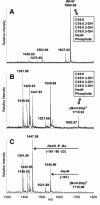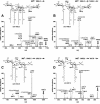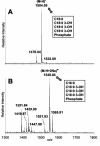Novel modification of lipid A of Francisella tularensis - PubMed (original) (raw)
Novel modification of lipid A of Francisella tularensis
Nancy J Phillips et al. Infect Immun. 2004 Sep.
Abstract
We have investigated the lipid A of Francisella tularensis subsp. holarctica strain 1547-57, a type B strain, by using matrix-assisted laser desorption ionization-time-of-flight mass spectrometry, nanoelectrospray quadrupole ion-trap mass spectrometry, and chemical methods. In accordance with the previously published structures of the lipid A from F. tularensis live vaccine strain (LVS) (ATCC 29684) (E. Vinogradov et al., Eur. J. Biochem. 269:6112-6118, 2002), all of the major lipid A forms from strain 1547-57 were tetraacylated. As in the LVS strain, the major fatty acids detected in the F. tularensis 1547-57 lipid A sample included 3-hydroxyoctadecanoic acid, 3-hydroxyhexadecanoic acid, hexadecanoic acid, and tetradecanoic acid. However, several of the lipid A components present in strain 1547-57 were of higher molecular weight than the previously published structures. A major component with an M(r) of 1,666 was found to contain three C(18:0)(3-OH) fatty acids, one C(16:0) fatty acid, one phosphate group, and one 161-Da moiety. This 161-Da moiety could be removed from the lipid A by treatment with aqueous hydrofluoric acid and was identified as galactosamine following peracetylation and analysis by gas chromatography-mass spectrometry. Detailed investigations of the M(r)-1,666 species by ion-trap mass spectrometry with multiple stages of fragmentation suggested that the galactosamine-1-phosphate was linked to the reducing terminus of the lipid A. Similar to the modification of lipid A with arabinosamine, lipopolysaccharide species from F. tularensis containing a phosphate-linked galactosamine could potentially influence its intracellular survival by conferring resistance to antimicrobial peptides.
Figures
FIG. 1.
GC-MS total ion chromatogram of the FAMEs derived from the lipid A of F. tularensis strain 1547-57.
FIG. 2.
Sections of three MALDI-TOF mass spectra of the F. tularensis strain 1547-57 lipid A sample, acquired in reflectron mode. (A) The negative-ion MALDI-TOF MS. (B) The positive-ion MALDI-TOF MS. (C) The positive-ion MALDI-TOF MS of the lipid A sample after HF treatment for 40 h.
FIG. 3.
Negative-ion nanoelectrospray MS_n_ spectra of the lipid A from F. tularensis strain 1547-57. (A) MS/MS of m/z 1,665.2. (B) MS3 of m/z 1,408.9. (C) MS3 of m/z 1,203.9. (D) MS3 of m/z 947.8.
FIG. 4.
Section of the positive-ion MALDI spectrum of the F. tularensis 1547-57 lipid A sample after reduction by treatment with NaBD4 for 4 h, acquired in reflectron mode. Insets show expansions of the indicated peaks. Asterisks mark the monoisotopic molecular ions of reduced species that have incorporated three deuterium atoms.
FIG. 5.
Proposed structure of the 1,666-_M_r component of the F. tularensis strain 1547-57 lipid A sample. The diglucosamine backbone bears four fatty acids: three C18:0(3-OH) fatty acids, and one C16:0 fatty acid. The acylation pattern shown is consistent with the arrangement determined for the lipid A of F. tularensis LVS (ATCC 29684) (27). The further modification of the _M_r-1,666 component of F. tularensis strain 1547-57 lipid A with a galactosamine-1-phosphate on the reducing terminus represents a novel structural feature not previously observed. The anomeric configuration of the galactosamine-1-phosphate linkage has not been determined.
FIG. 6.
Sections of the MALDI-TOF mass spectra of the lipid A from F. tularensis LVS recorded in negative-ion (A) and positive-ion (B) reflectron modes. For comparison to the F. tularensis strain 1547-57 lipid A sample, refer to Fig. 2. For proposed compositions, see the text and Table 1.
Similar articles
- Structure and biosynthesis of free lipid A molecules that replace lipopolysaccharide in Francisella tularensis subsp. novicida.
Wang X, Ribeiro AA, Guan Z, McGrath SC, Cotter RJ, Raetz CR. Wang X, et al. Biochemistry. 2006 Dec 5;45(48):14427-40. doi: 10.1021/bi061767s. Biochemistry. 2006. PMID: 17128982 Free PMC article. - A variety of novel lipid A structures obtained from Francisella tularensis live vaccine strain.
Beasley AS, Cotter RJ, Vogel SN, Inzana TJ, Qureshi AA, Qureshi N. Beasley AS, et al. Innate Immun. 2012 Apr;18(2):268-78. doi: 10.1177/1753425911401054. Epub 2011 Jun 27. Innate Immun. 2012. PMID: 21709054 Free PMC article. - Structural analysis of Francisella tularensis lipopolysaccharide.
Vinogradov E, Perry MB, Conlan JW. Vinogradov E, et al. Eur J Biochem. 2002 Dec;269(24):6112-8. doi: 10.1046/j.1432-1033.2002.03321.x. Eur J Biochem. 2002. PMID: 12473106 - Surface analysis of lipids by mass spectrometry: more than just imaging.
Ellis SR, Brown SH, In Het Panhuis M, Blanksby SJ, Mitchell TW. Ellis SR, et al. Prog Lipid Res. 2013 Oct;52(4):329-53. doi: 10.1016/j.plipres.2013.04.005. Epub 2013 Apr 24. Prog Lipid Res. 2013. PMID: 23623802 Review.
Cited by
- Study of matrix additives for sensitive analysis of lipid A by matrix-assisted laser desorption ionization mass spectrometry.
Zhou P, Altman E, Perry MB, Li J. Zhou P, et al. Appl Environ Microbiol. 2010 Jun;76(11):3437-43. doi: 10.1128/AEM.03082-09. Epub 2010 Apr 9. Appl Environ Microbiol. 2010. PMID: 20382818 Free PMC article. - Characterization of htrB and msbB mutants of the light organ symbiont Vibrio fischeri.
Adin DM, Phillips NJ, Gibson BW, Apicella MA, Ruby EG, McFall-Ngai MJ, Hall DB, Stabb EV. Adin DM, et al. Appl Environ Microbiol. 2008 Feb;74(3):633-44. doi: 10.1128/AEM.02138-07. Epub 2007 Dec 7. Appl Environ Microbiol. 2008. PMID: 18065606 Free PMC article. - Complete Structural Elucidation of Monophosphorylated Lipid A by CID Fragmentation of Protonated Molecule and Singly Charged Sodiated Adducts.
Aissa I, Dörnyei Á, Sándor V, Kilár A. Aissa I, et al. J Am Soc Mass Spectrom. 2023 Jan 4;34(1):92-100. doi: 10.1021/jasms.2c00269. Epub 2022 Dec 20. J Am Soc Mass Spectrom. 2023. PMID: 36539922 Free PMC article. - Phase Variation of LPS and Capsule Is Responsible for Stochastic Biofilm Formation in Francisella tularensis.
Mlynek KD, Lopez CT, Fetterer DP, Williams JA, Bozue JA. Mlynek KD, et al. Front Cell Infect Microbiol. 2022 Jan 14;11:808550. doi: 10.3389/fcimb.2021.808550. eCollection 2021. Front Cell Infect Microbiol. 2022. PMID: 35096655 Free PMC article. - The Biosynthesis of Lipooligosaccharide from Bacteroides thetaiotaomicron.
Jacobson AN, Choudhury BP, Fischbach MA. Jacobson AN, et al. mBio. 2018 Mar 13;9(2):e02289-17. doi: 10.1128/mBio.02289-17. mBio. 2018. PMID: 29535205 Free PMC article.
References
- Boll, M., J. Radziejewska-Lebrecht, C. Warth, D. Krajewska-Pietrasik, and H. Mayer. 1994. 4-Amino-4-deoxy-L-arabinose in LPS of enterobacterial R-mutants and its possible role for their polymyxin reactivity. FEMS Immunol. Med. Microbiol. 8:329-341. - PubMed
- Caroff, M., A. Tacken, and L. Szabo. 1988. Detergent-accelerated hydrolysis of bacterial endotoxins and determination of the anomeric configuration of the glycosyl phosphate present in the “isolated lipid A” fragment of the Bordetella pertussis endotoxin. Carbohydr. Res. 175:273-282. - PubMed
- Corsaro, M. M., F. D. Piaz, R. Lanzetta, and M. Parrilli. 2002. Lipid A structure of Pseudoalteromonas haloplanktis TAC 125: use of electrospray ionization tandem mass spectrometry for the determination of fatty acid distribution. J. Mass Spectrom. 37:481-488. - PubMed
- Costello, C. E., and J. E. Vath. 1990. Tandem mass spectrometry of glycolipids. Methods Enzymol. 193:738-768. - PubMed
Publication types
MeSH terms
Substances
LinkOut - more resources
Full Text Sources
Other Literature Sources
Research Materials





